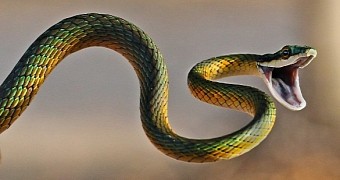About 128 million years ago, in the Early Cretaceous period, forested lands in our planet's southern hemisphere were home to borderline alienesque and definitely bizarre snakes with legs, Yale University researchers argue in a new paper published in the journal BMC Evolutionary Biology.
When they say that these ancestral snakes had legs, the Yale University paleontologists don't just mean that they had limb-like appendages growing on the sides of their body. They mean actual legs, complete with ankles and toes.
In their report in the journal BMC Evolutionary Biology, the scientists propose that these early snakes were nocturnal creatures that fed on fairly large prey. Unlike anacondas and pythons, however, they didn't choke their victims to death. Instead, they relied on hooked teeth to snatch their next meal.
It is these peculiar snakes with legs that populated Earth's southern hemisphere during the Early Cretaceous period that the paleontologists believe eventually evolved into the slithering reptiles now inhabiting our planet.
“We infer that the most recent common ancestor of all snakes was a nocturnal, stealth-hunting predator targeting relatively large prey, and most likely would have lived in forested ecosystems in the Southern Hemisphere,” Yale University researcher and study lead author Allison Hsiang said in a statement.
How do they know what ancient snakes look like?
To reveal the origin of modern snakes and deliver a more detailed account of the evolutionary history of these reptiles, paleontologist Allison Hsiang and colleagues looked at the genetic makeup and the anatomy of the species that now roam the Earth.
Whatever information was obtained in this manner was coupled with data provided by fossil evidence. The investigation allowed the researchers to put together a family tree documenting both living snakes and species that have long gone extinct.
Based on this family tree of living and extinct species, the Yale University team of paleontologists succeeded in identifying the major evolutionary patterns that ultimately gave rise to the slithering, legless creatures we refer to as snakes in this day and age.
The researchers found that, having started off as creatures with a complete set of legs, ancestral snakes evolved over the millennia to have just two - at which point they became the most recent common ancestor of all living snakes - and then further evolved to achieve great diversity.
As detailed by study co-author Daniel Field, “Our analyses suggest that the most recent common ancestor of all living snakes would have already lost its forelimbs, but would still have had tiny hind limbs, with complete ankles and toes.”
The Yale University team hopes that, by better understanding the evolutionary history of snakes, they might gain new insights into how and why the brain of primates - humans included - is hardwired to fear these creatures and react to their presence.

 14 DAY TRIAL //
14 DAY TRIAL // 

